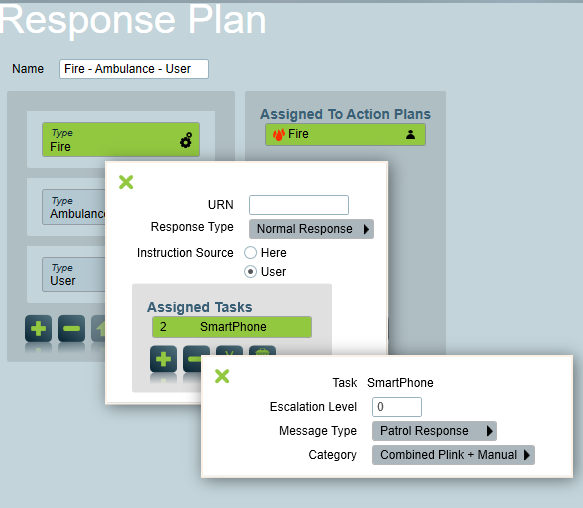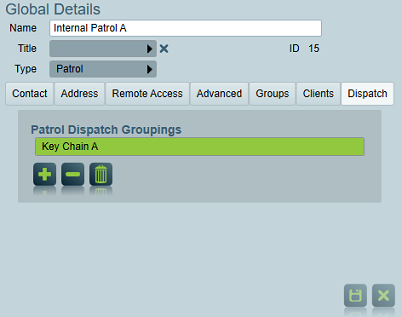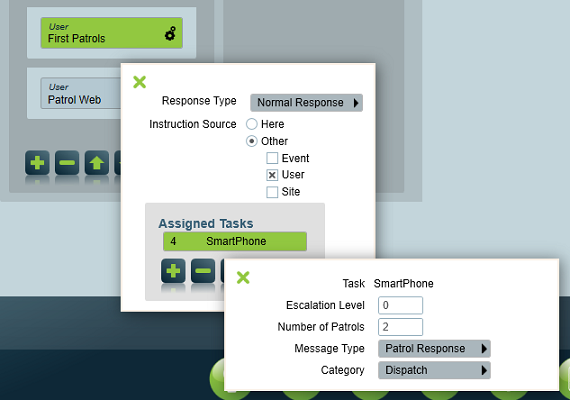Automatic Dispatch
Automatic dispatch allows for dispatch to both internal and external response services allowing monitoring stations to operate in an unmanned fashion.
The Automatic Dispatch feature can automatically:
- Send dispatch requests via Plink app notification, email, SMS, or a custom notification task developed with Patriot task plugin API.
- Broadcast dispatch requests to one or more Plink app users from the same dispatch company
- Complete the associated activation when the dispatch job is completed.
Prerequisites
- To dispatch via Plink app the Patrol Response module is required.
- To broadcast dispatch requests to a number of plink patrols, the Dispatch Module is required. This enables the Select Patrol Dispatch feature.
- To dispatch via Email or SMS the Web Dispatch module is required along with the Email module or an SMS module.
- To dispatch via a custom notification task the Generic Dispatch module is required.
- Patriot version 6.9.9.1 or later.
- Patriot Internet Client Access (ICA) configured.
- Standard Plink setup/configured. See the Smart Phone documentation for initial Plink setup.
- Plink app version 9.13.0 or later for automatic broadcast dispatch via Plink app
User Setup
Instructions for configuring a user to receive a web dispatch (i.e. an email or SMS containing an ICA link to the dispatch) can be found in the Web Dispatch documentation. To set up automatic Plink dispatches, look at "General Patrol Setup" section of the Patrol Response Features document.
Broadcast to multiple patrols
If you wish to broadcast to a group of patrols, they must be grouped together by being linked to the same "Select Patrol Dispatch" user. Where a Select Patrol Dispatch user is on the automatic dispatch response plan, all linked Plink users will also receive a dispatch request automatically. These linked users must also be on the same Patrol Dispatch grouping as the client to receive the dispatch job.
Response Plan Setup
Assign tasks to your response plans to trigger automatic dispatch. Assign the Smart Phone task for Plink dispatch or an Email and/or SMS task for Web Dispatch.
Beware that a task assignment will only trigger an automatic dispatch to a user if that user supports the task's dispatch method. i.e. if you assign a Smart Phone task to a user that does not have Plink Dispatch enabled then no dispatch will occur. Likewise if you assign an Email or SMS task to a user that does not have Web Dispatch enabled, or if the user's Web Dispatch Notification Task does not match your task assignment, then no dispatch will occur. Make sure to consider this when assigning tasks at the user group or user type level - you may need to assign multiple Web or Plink Dispatch tasks to ensure all users within the group or type receive the dispatch.
Double click the task, for a popup to appear. Choose 'Patrol Response' as the message type so that when an activation is created, a dispatch job is automatically created and sent out to the appropriate users either as a web dispatch (email or SMS) or plink dispatch (smartphone notification).

Dispatch Rules
- When a response plan contains multiple users with a Patrol Response task assignment, multiple dispatch jobs will be created.
- When a response plan contains a user with multiple Patrol Response task assignments, multiple dispatch jobs will be created.
- Only one dispatch job, per dispatch type, per user can be pending for a single activation at the same time. This means that duplicate dispatch jobs will not be created automatically if multiple alarms signals are logged against the same activation. But it is possible for a patrol user to have a web dispatch job and a plink dispatch job pending for the same activation at the same time. It is also possible to have multiple patrols with pending dispatch jobs of the same type (i.e. Plink) open for the same activation at the same time.
- When a response plan contains a user with a Patrol Response task assignment (task type must be SmartPhone) and the user has the "Select Dispatch Patrol" option enabled (i.e. they represent a patrol company that may have many individual patrols) then a Plink dispatch notification may be sent to multiple linked patrols - see Automatic Dispatch With Select Patrol Dispatch for more information.
Select patrol dispatch should not be added to a response plan which contains any other patrol dispatch assignments (individual or select patrol). Patriot will not allow a select patrol automatic dispatch if the activation already has a dispatch job pending.
- When a response plan contains a user with a Patrol Response task assignment but the user does not have the "Select Dispatch Patrol" option enabled (i.e. they represent an individual patrol) then a Plink or Web dispatch notification will be sent directly to the selected automatic dispatch user only.
Automatic Dispatch With Select Patrol Dispatch
To receive the dispatch request, the individual patrol user(s) must:
- Be linked to the Selected Patrol User. See the "General Patrol Setup" section of this document for details of how this is configured.
- Have Plink Dispatch enabled. Automatic dispatch through Selected Patrol Dispatch only supports sending dispatch request via Plink.
- Meet the filter criteria defined by your Automatic Dispatch Patrol Selection Rules.
Select Patrol Dispatch has two modes: Broadcast and Multiple Jobs - which mode you are in depends on your system wide setting Automatic Dispatch Type.
- Broadcast - all suitable patrols will be notified but only one dispatch job created - the first patrol to accept the dispatch will be assigned to the job.
- Multiple Jobs - all suitable patrols will be notified and assigned to their own dispatch job (multiple jobs are created).
Select Patrol Broadcast Dispatch
In this mode Patriot will create a single dispatch job and immediately send a notification about the dispatch job to those patrols which rank the highest according to your Automatic Dispatch Patrol Selection Rules. If none of these ranking patrols accept the job within the system wide setting Automatic Dispatch Delay Time, then notification(s) about the job will also be sent out to any lower ranking patrols.
Once one of the patrols linked to the "Select Patrol Dispatch" user accepts the job, the other linked patrols who were sent a notification will lose access to the dispatch job.
For example, if you set the rule Client Groupings Match to Rank, when the activation client belongs to the group "Key Chain A", the patrol user below will receive the dispatch request as soon as the activation is created. If this user doesn't have "Key Chain A" as one of their Patrol Dispatch groupings, then they will receive the request only after those patrol users who have "Key Chain A" failed to pick up the dispatch job on time.

In the case that no patrol users pick up the dispatch job within the dispatch request Acceptance Warning Time (set in the system wide response settings), then a warning note will be logged against the dispatch job and the operator will be notified (if applicable).
Select Patrol Multiple Job Dispatch

In this mode Patriot will create multiple dispatch jobs, one job is created for each matching patrol according to your Automatic Dispatch Patrol Selection Rules, up to the maximum number specified in the response plan task assignment.
All patrols are immediately notified about their new dispatch job.
If the select patrol has more matching patrols than specified in the response plan assignment, then only the highest ranking patrols, again according to your Automatic Dispatch Patrol Selection Rules, will receive a job and notification. If there are less matching patrols than specified then Patriot will create as many jobs as possible, and then log a warning note about the deficit against the activation client. If however no matching patrols are found at all then an error signal will be logged against the activation client.
Complete the Activation
To enable the monitoring station to run in an unmanned fashion, a dispatch job that created by the Automatic Dispatch feature can complete the activation once all the following conditions are satisfied:
- The dispatch job is completed.
- No operators or users took ownership of the activation.
- No other pending dispatch jobs on this activation.
- The Action On Dispatch Completed setting is set to "Complete Activation" in System Wide Settings
Using escalated messaging with automatic dispatching
You can use escalated messaging to send a patrol response as a last resort. Read through escalated messaging for more info.